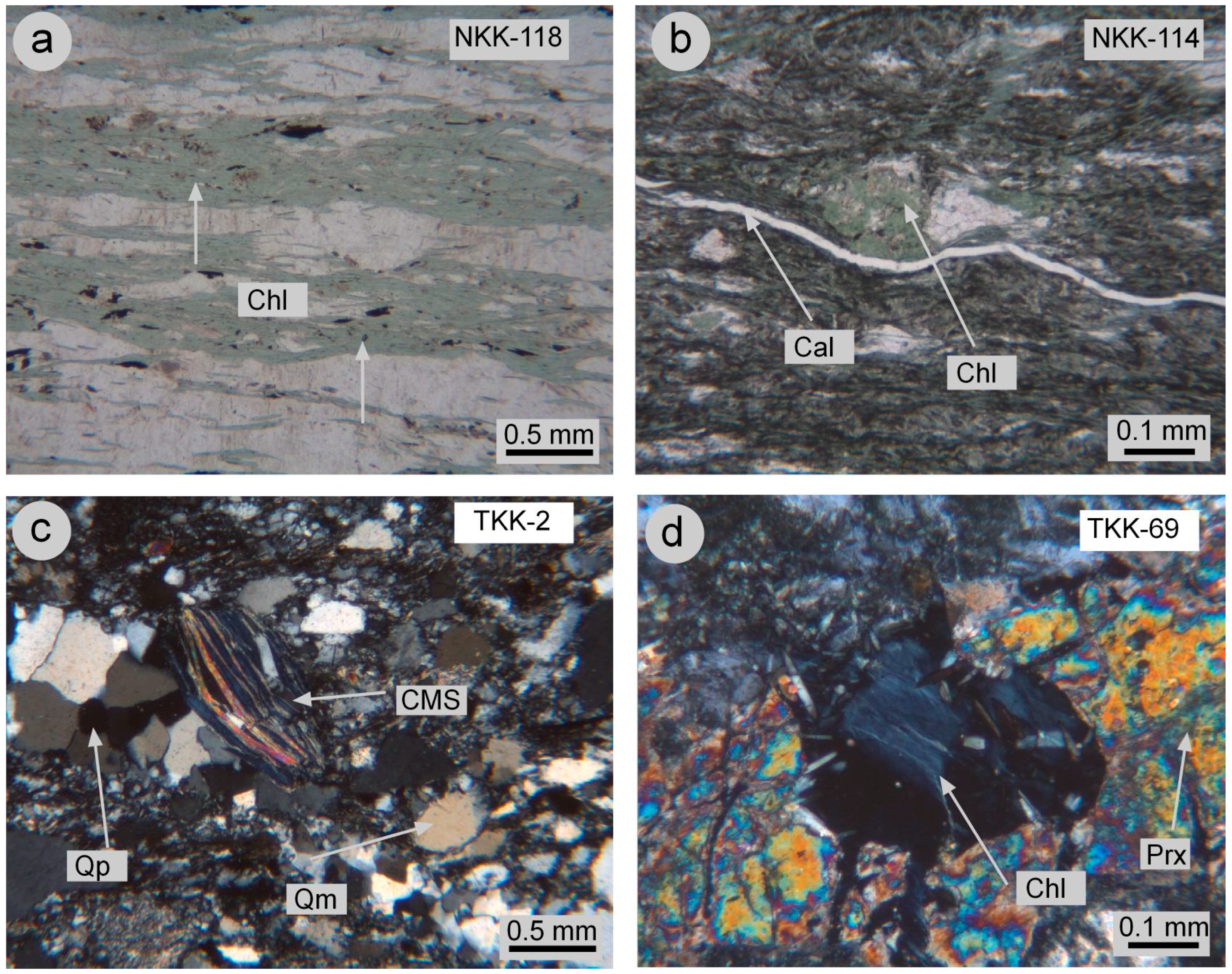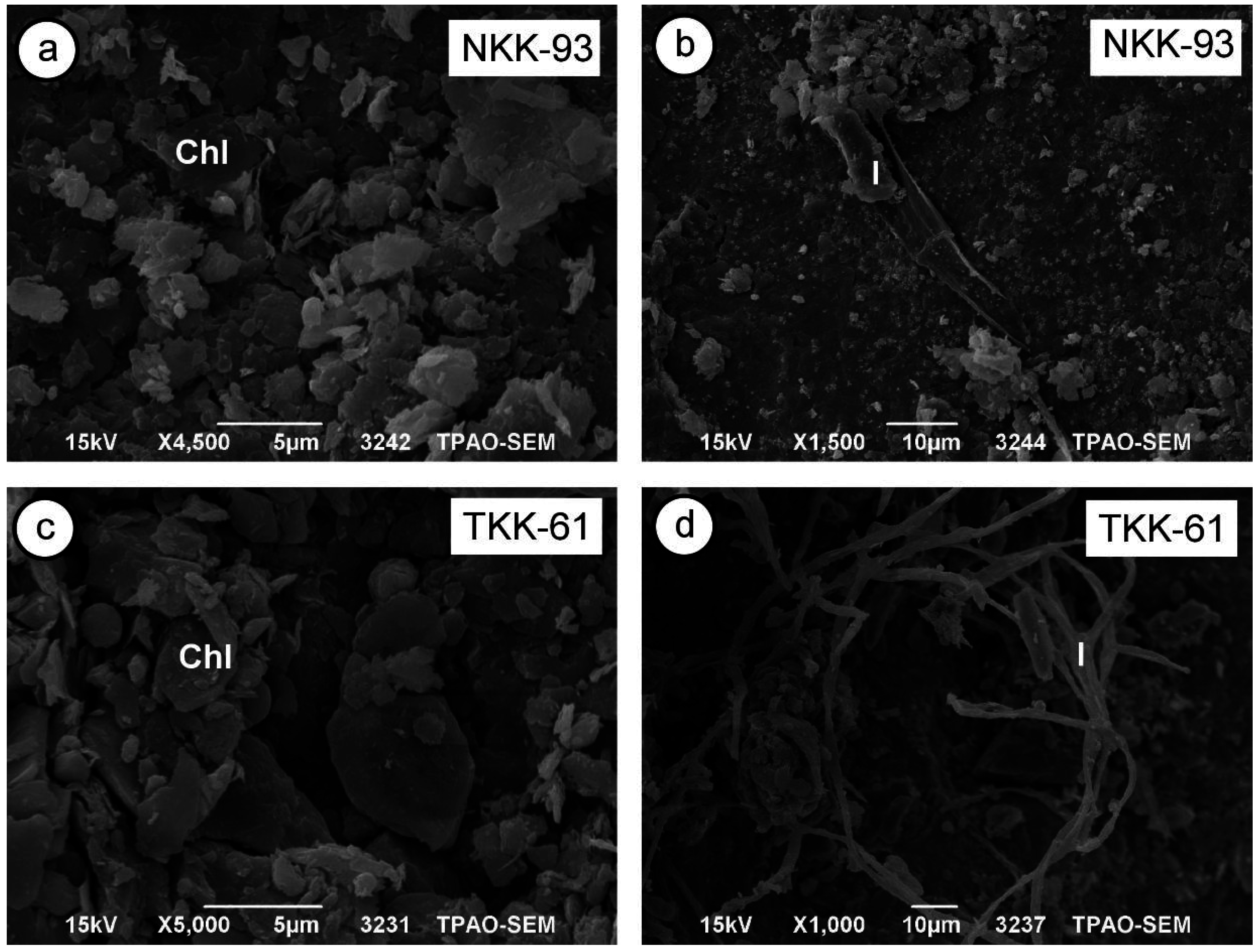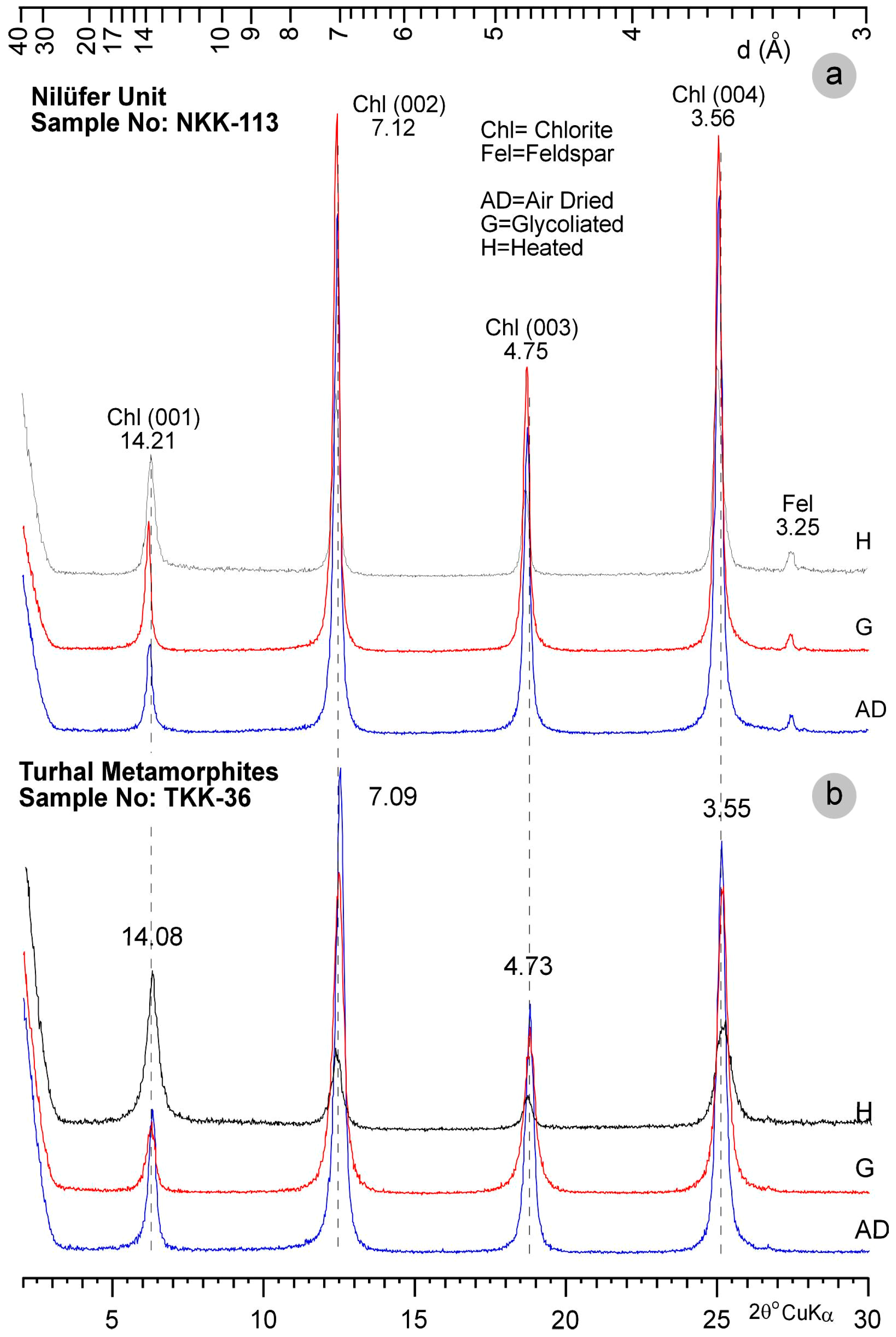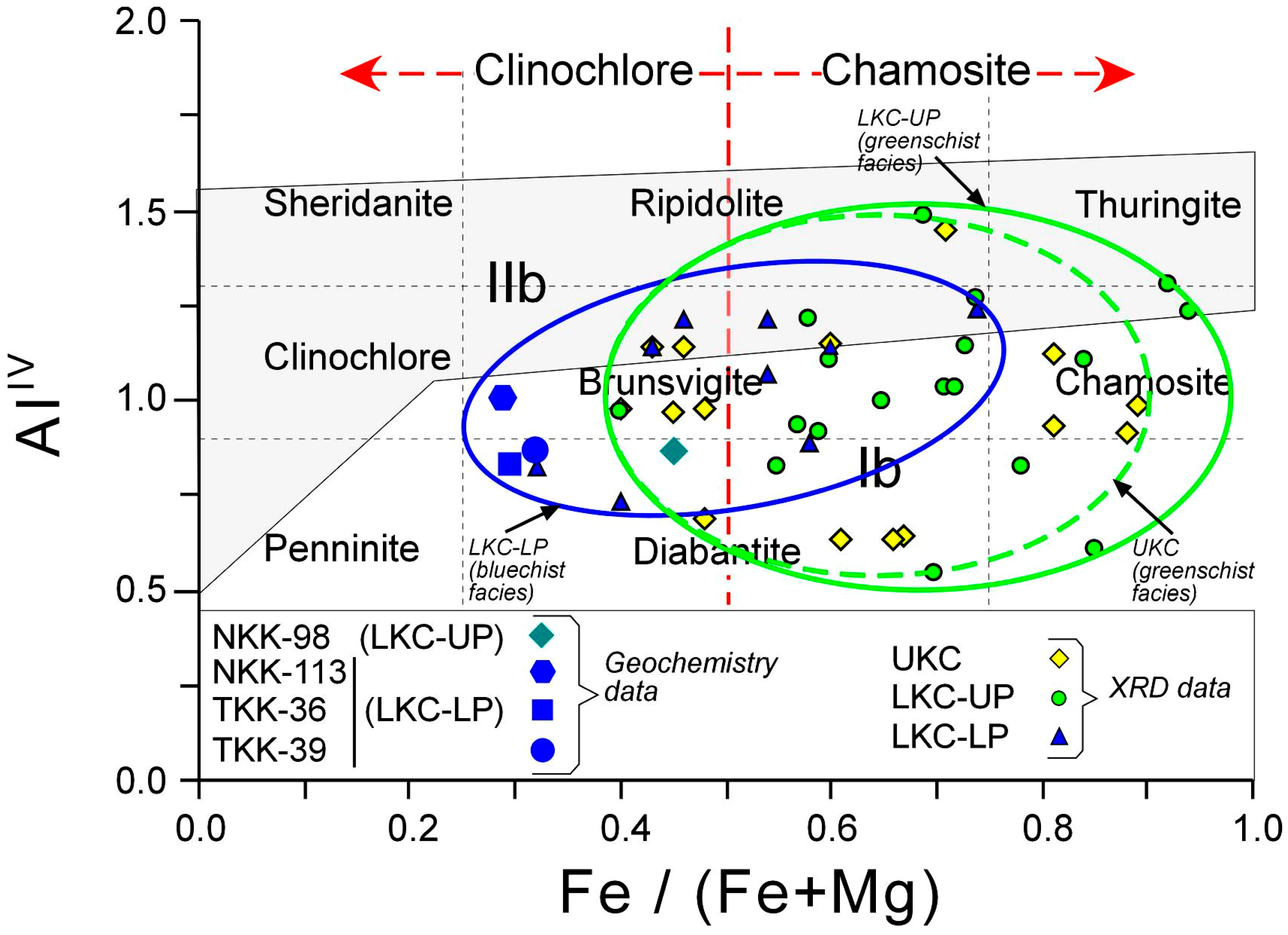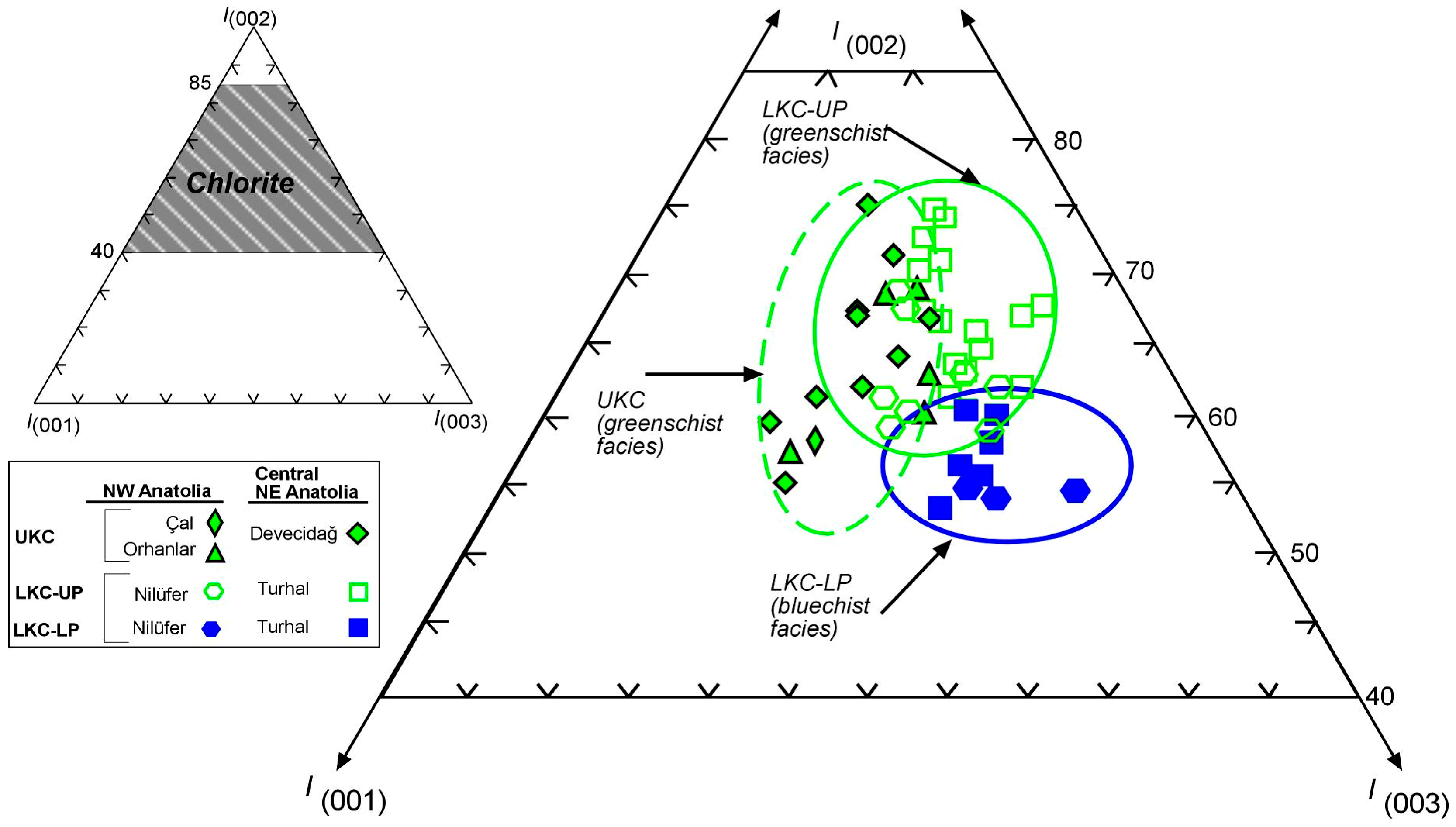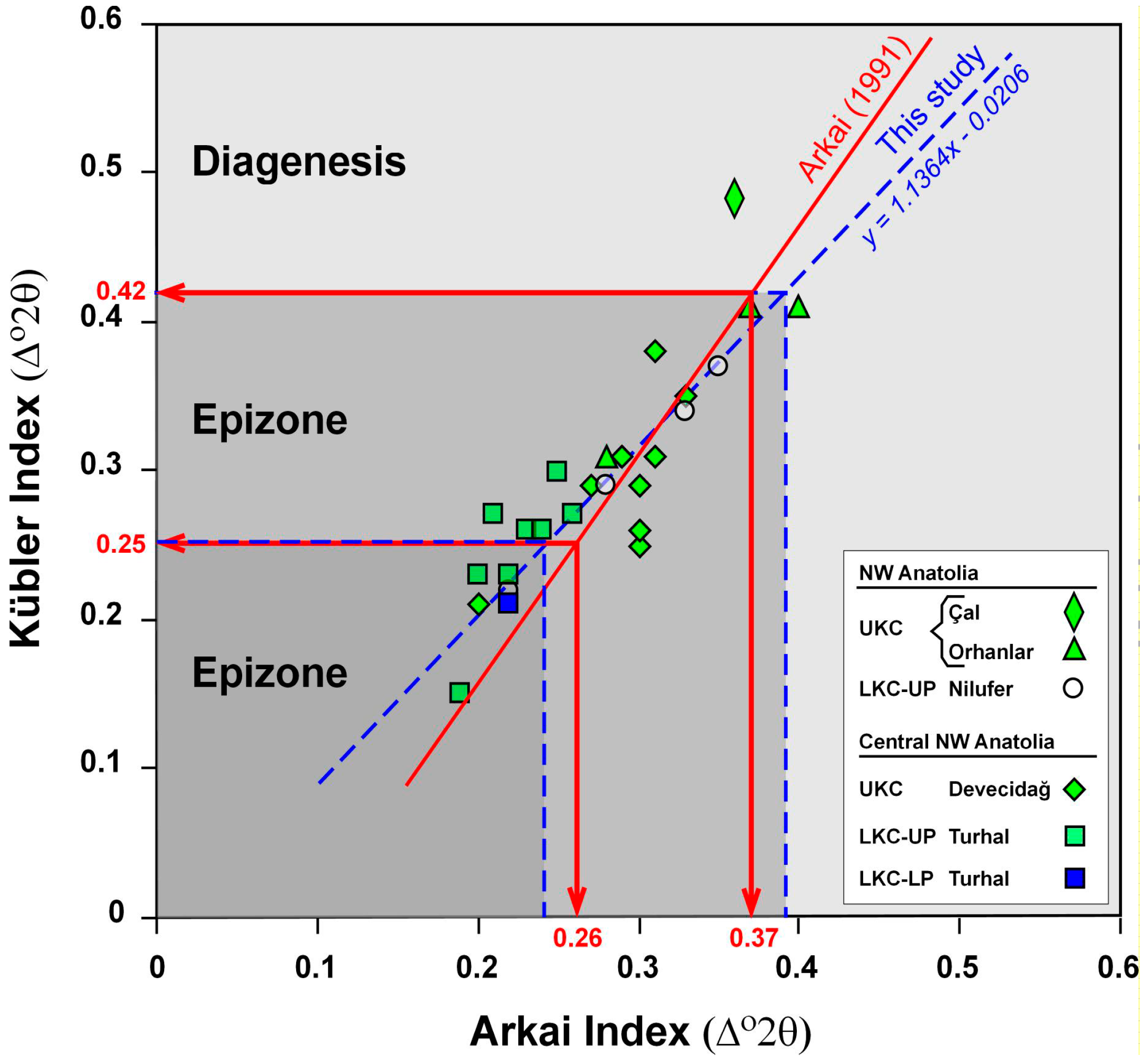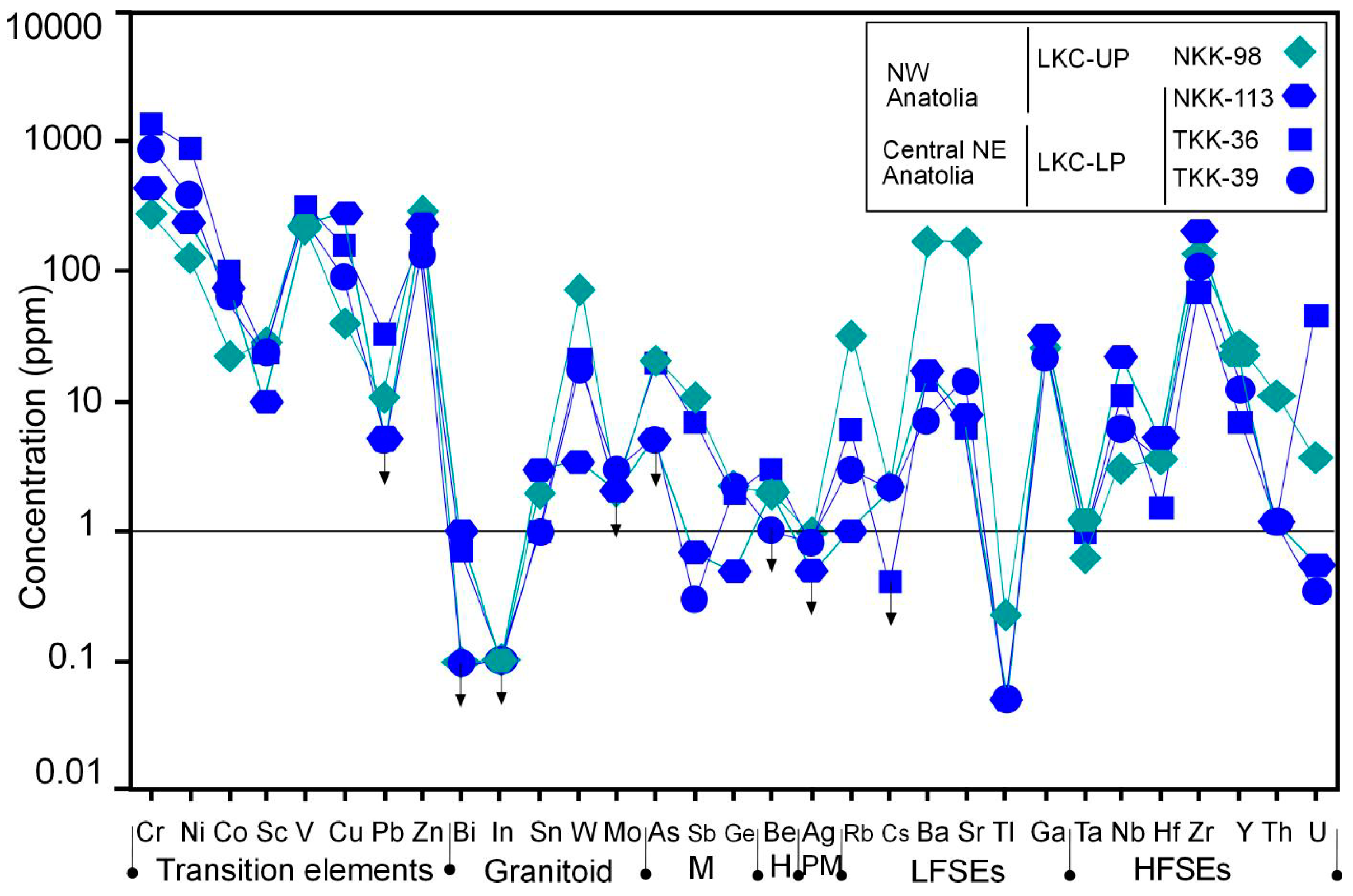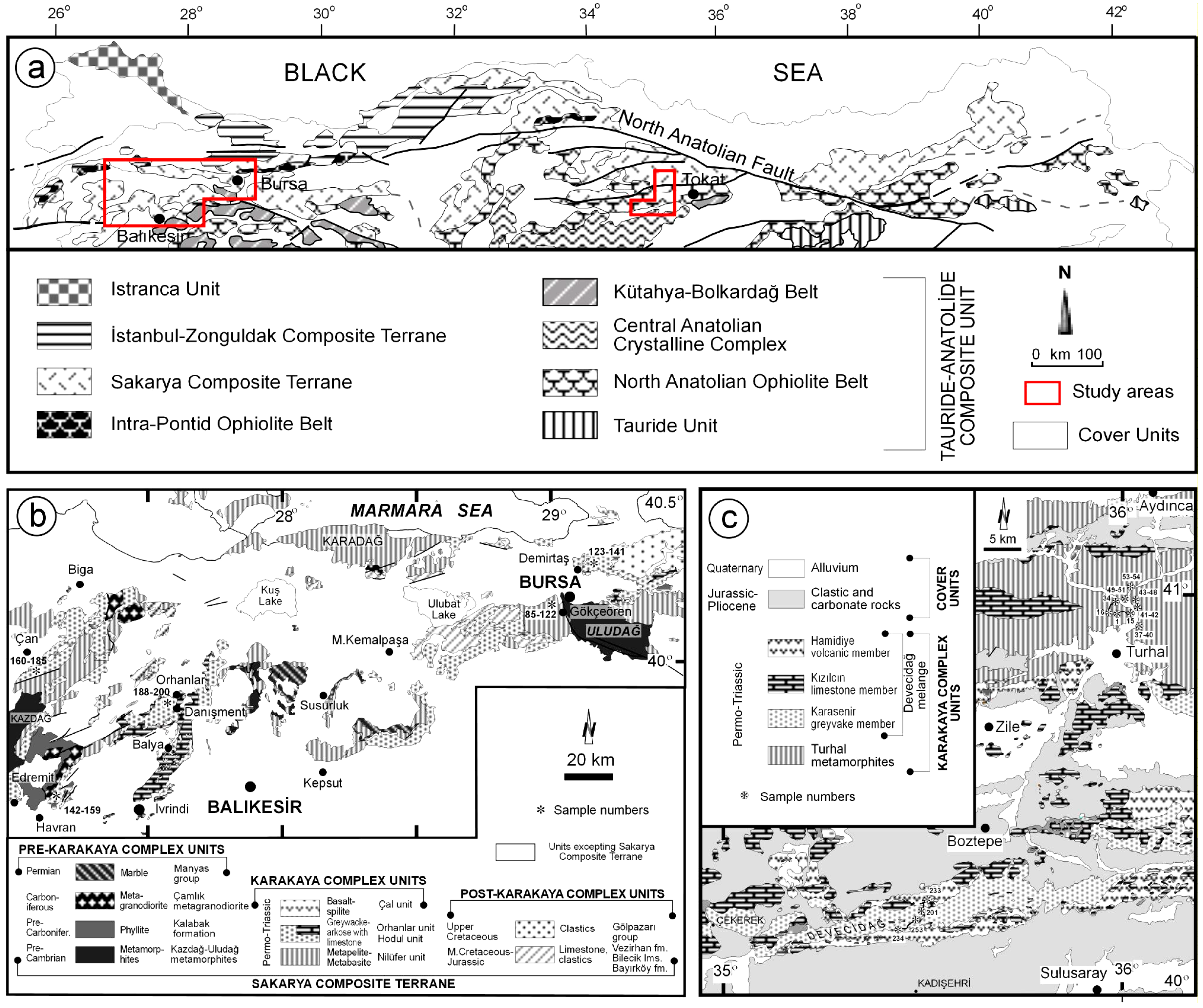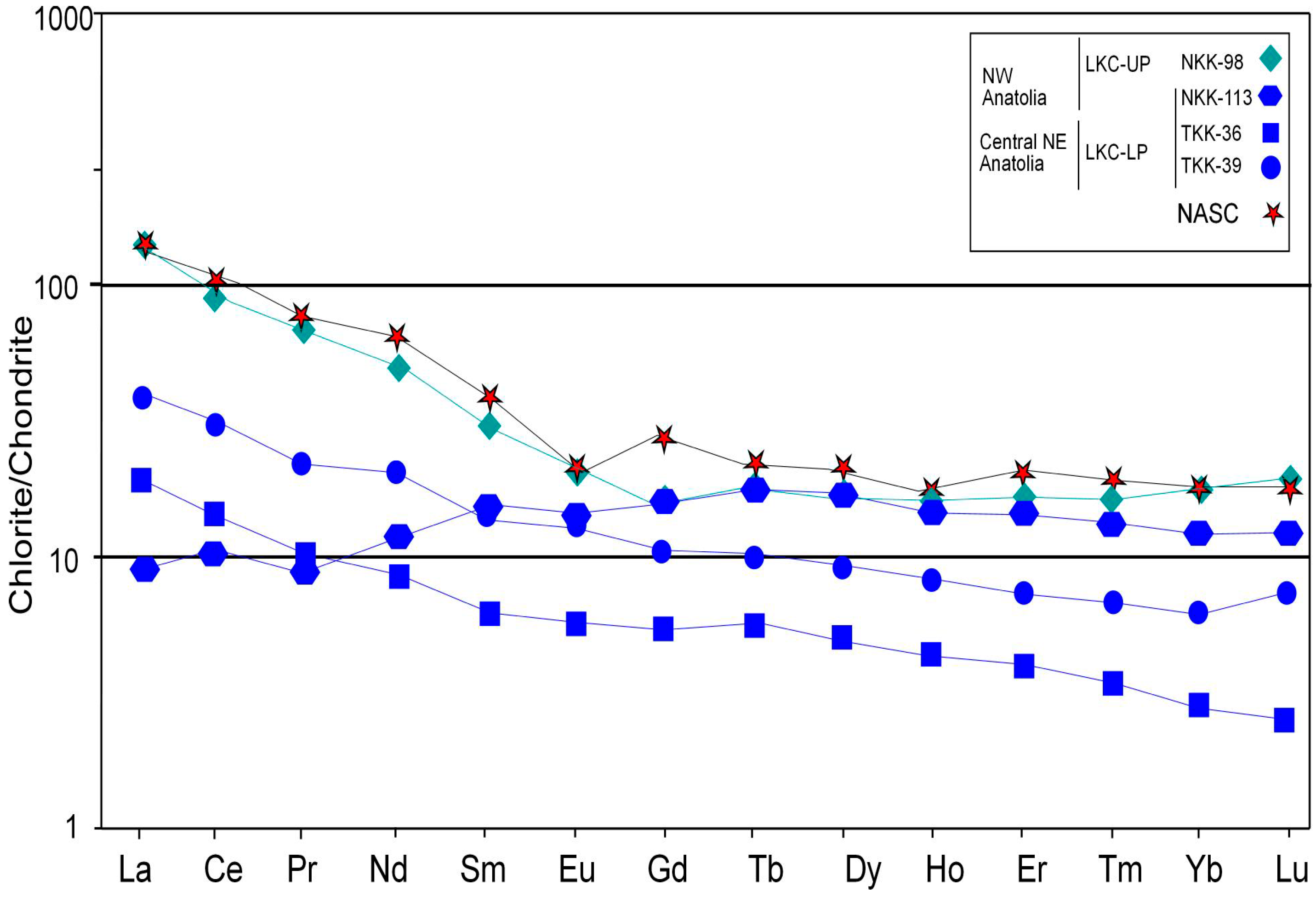4.2.1. Whole Rock and Clay Fraction
The mineralogical composition of rocks within the KC units is given in
Table 1. Volcanogenic (feldspar, augite), metamorphic-metasomatic (glaucophane, tremolite/actinolite, epidote, stilpnomelane, phyllosilicates), and secondary minerals (calcite, dolomite, quartz, hematite, goethite) were recorded in metapelitic and metavolcanogenic rocks constituting the LKC-LP Nilüfer Unit in NW Anatolia. Phyllosilicate minerals consist of chlorite + illite unity and stilpnomelane, smectite and mixed-layer (C-S and C-V) minerals are involved in this unity to a lesser amount. In slate, chlorite wholly represents the clay fraction (
Figure 5a).
Volcanogenic (feldspar), metamorphic-metasomatic (glaucophane, tremolite/actinolite, epidote, stilpnomelane, paragonite, phyllosilicates) and secondary chemical minerals (calcite, dolomite, quartz, hematite, goethite) were noted in metamagmatic and metapelitic rocks of LKC-LP Turhal Metamorphites in the central NE Anatolia. Pure chlorite (
Figure 5b) represents the phyllosilicate mineral in metatuffites and the chlorite + illite association in the remaining rocks.
Figure 4.
Scanning electron microscopy (SEM) photos of chlorite and associated minerals in the Lower Karakaya Complex units (Chl = Chlorite, I = Illite), (a) Platy chlorites in the shale sample of the Nilüfer Unit; (b) Thin-long filaments of illites in the shale sample of the Nilüfer Unit; (c) Radial needle-like chlorites and surrounding illites within the pores of metasandstones in the Turhal Metamorphites; (d) Fibrous illites in the metasandstones of the Turhal Metamorphites.
Figure 4.
Scanning electron microscopy (SEM) photos of chlorite and associated minerals in the Lower Karakaya Complex units (Chl = Chlorite, I = Illite), (a) Platy chlorites in the shale sample of the Nilüfer Unit; (b) Thin-long filaments of illites in the shale sample of the Nilüfer Unit; (c) Radial needle-like chlorites and surrounding illites within the pores of metasandstones in the Turhal Metamorphites; (d) Fibrous illites in the metasandstones of the Turhal Metamorphites.
Table 1.
The dominant mineralogy of samples from the Karakaya Complex (KC) units.
Table 1.
The dominant mineralogy of samples from the Karakaya Complex (KC) units.
| Unit | Area | KC | Facies | Minerals |
|---|
| Çal | NW Anatolia | UKC | Greenschist | chlorite, illite, C-V, C-S |
| Orhanlar | chlorite, illite, C-S, C-V, I-S, epidote |
| Hodul | illite, chlorite, I-S, C-V |
| Nilüfer | LKC-UP | augite, hornblende, epidote, stilpnomelane, illite, chlorite, C-S, C-V, I-S |
| LKC-LP | Blueschist | glaucophane, tremolite/actinolite, augite, epidote, stilpnomelane, chlorite, illite, C-V, C-S |
| Devecidağ Melange | Central NE Anatolia | UKC | Greenschist | augite, epidote, prehnite, illite, chlorite, C-S, C-V, I-C, I-S |
| Turhal Metamorphites | LKC-UP | augite, epidote, illite, chlorite, paragonite, stilpnomelane, I-C, I-S, C-S, C-V |
| LKC-LP | Blueschist | glaucophane, tremolite/actinolite, epidote, stilpnomelane, paragonite, illite, chlorite |
Figure 5.
Oriented X-ray diffraction (XRD) patterns of chlorite minerals in the units of Lower Karakaya Complex-Lower Part, (a) Slate sample of blueschist facies in the Nilüfer Unit; (b) Metatuffite sample of greenschist facies in the Turhal Metamorphites.
Figure 5.
Oriented X-ray diffraction (XRD) patterns of chlorite minerals in the units of Lower Karakaya Complex-Lower Part, (a) Slate sample of blueschist facies in the Nilüfer Unit; (b) Metatuffite sample of greenschist facies in the Turhal Metamorphites.
Volcanogenic (pyroxene, feldspar), metamorphic-metasomatic (amphibole, epidote, stilpnomelane), and secondary minerals (calcite, dolomite, quartz, hematite, goethite) were detected in metapsammite, metapelite, metacarbonate, and metabasic rocks representing LKC-UP in NW Anatolia. While phyllosilicates are mostly represented by illite + chlorite paragenesis, in some instances this assemblage is accompanied by stilpnomelane, smectite, kaolinite, and mixed-layer (C-S, C-V and I-S) minerals.
Metapelitic, metapsammitic, metamagmatic, and metalimestones in LKC-UP in the central NE Anatolia contain feldspar, phyllosilicate, quartz, pyroxene, epidote, stilpnomelane, paragonite, calcite, dolomite, hematite, and goethite minerals. In these rocks, illite, chlorite, kaolinite, smectite, paragonite, stilpnomelane, and mixed layer (I-C, I-S, C-S and C-V) minerals represent phyllosilicates in the order of abundance. In these samples, illite + chlorite association constitutes the widespread phyllosilicate paragenesis. While the assemblage of illite + chlorite is observed in certain metasedimentary rocks, the association of chlorite + stilpnomelane was detected in metavolcanic rocks. Illite + kaolinite + smectite, illite + chlorite + paragonite + I-S and illite + chlorite + I-C or C-V assemblages constitute other parageneses.
Clastic rocks and (meta-) limestones of the Hodul Unit within the UKC in NW Anatolia contain quartz, phyllosilicate (illite, kaolinite, I-S, C-V, smectite and chlorite), calcite, and feldspar. Clastic rocks and (meta-) limestones of the Orhanlar Unit have quartz, feldspar, phillosilicate (chlorite, illite, C-S, C-V and I-S), calcite, and epidote minerals. Calcite, phyllosilicate (chlorite, C-S, vermiculite, illite and C-V), quartz, feldspar, hematite, and dolomite minerals were recorded in metavolcanic, shale and limestones of the Çal Unit.
Metapelitic, metapsammitic, metavolcanic, and metalimestones from the Devecidağ Melange within the UKC units in central NE Anatolia consist of quartz, feldspar, phyllosilicate (illite, chlorite, C-S, C-V, smectite, kaolinite, I-C and I-S), pyroxene, epidote, hematite, dolomite, and prehnite minerals.
4.2.3. Composition
The chemical compositions of the chlorites for the LKC units determined in accordance with basal peak values and intensity ratios are listed in
Table 3 and
Table 4 and shown in
Figure 7. The reflection values of the (001) surface in the chlorites in NW Anatolia vary between 14.189–14.338 Å (14.249 Å on average) for LKC-LP and 14.172–14.392 Å (14.262 Å on average) for LKC-UP; and 14.202–14.366 Å (14.275 Å on average) for the Orhanlar Unit. For the Çal Unit, the average reflection value is 14.269 Å.
Figure 7.
Fe content within the talc layer and distribution of talc and brucite layers of chlorite minerals according to basal peak ratios [
44] in the Karakaya Complex units.
Figure 7.
Fe content within the talc layer and distribution of talc and brucite layers of chlorite minerals according to basal peak ratios [
44] in the Karakaya Complex units.
Table 3.
X-ray diffraction (XRD) basal reflections and chemical compositions of chlorite minerals in the Lower Karakaya Complex units. B: Brindley [
42], B&B: Brindley and Brown [
43], C&D: Chagnon and Desjardins [
44]), Al
IV = Al
VI and Mg = 6 − (Fe + Al
IV).
Table 3.
X-ray diffraction (XRD) basal reflections and chemical compositions of chlorite minerals in the Lower Karakaya Complex units. B: Brindley [42], B&B: Brindley and Brown [43], C&D: Chagnon and Desjardins [44]), AlIV = AlVI and Mg = 6 − (Fe + AlIV).
| Sample No. | d(001) (Å) | I(003)/I(001) | I(002 + 004)/I(001 + 003) | I(002)/I(001) | I(004)/I(003) | Talc Fe+2 | Brucite Fe+2 | Σ Fe+2 | AlIV | MgVI | Fe/(Fe + Mg) |
|---|
| B&B | C&D | B&B | C&D | B&B | C&D | B&B | C&D | C&D |
|---|
| NW Anatolia |
| LKC-UP (Greenschist facies) |
| NKK-95 | 14.231 | 1.26 | 4.05 | 5.89 | 2.59 | 1.87 | 1.98 | 2.58 | 2.13 | 4.45 | 4.11 | 1.10 | 0.79 | 0.84 |
| -96 | 14.392 | 2.16 | 3.39 | 5.01 | 2.64 | 1.07 | 1.90 | 2.60 | 1.90 | 3.67 | 3.80 | 0.54 | 1.66 | 0.70 |
| -97 | 14.172 | 1.36 | 4.02 | 5.79 | 2.71 | 1.79 | 2.10 | 2.61 | 2.20 | 4.40 | 4.30 | 1.30 | 0.40 | 0.92 |
| -98 | 14.311 | 1.29 | 2.88 | 3.89 | 2.10 | 1.13 | 1.43 | 1.88 | 1.44 | 3.01 | 2.87 | 0.82 | 2.31 | 0.55 |
| -103 | 14.280 | 1.98 | 2.72 | 3.77 | 2.19 | 0.69 | 1.48 | 2.09 | 1.40 | 2.78 | 2.88 | 0.93 | 2.19 | 0.57 |
| -106 | 14.200 | 1.18 | 2.81 | 3.51 | 2.22 | 1.15 | 1.50 | 1.76 | 1.30 | 2.91 | 2.80 | 1.21 | 1.99 | 0.58 |
| -108 | 14.287 | 1.13 | 2.98 | 3.70 | 2.34 | 1.30 | 1.60 | 1.84 | 1.40 | 3.14 | 3.00 | 0.91 | 2.09 | 0.59 |
| -111 | 14.220 | 1.95 | 3.33 | 5.65 | 2.15 | 1.11 | 1.60 | 2.49 | 1.95 | 3.60 | 3.55 | 1.14 | 1.31 | 0.73 |
| LKC-LP (Blueschist facies) |
| -113 | 14.220 | 3.44 | 2.67 | 5.77 | 1.77 | 0.24 | 1.20 | 2.47 | 1.70 | 2.71 | 2.90 | 1.14 | 1.96 | 0.60 |
| -115 | 14.189 | 2.53 | 3.23 | 6.43 | 1.97 | 0.85 | 1.50 | 2.62 | 2.00 | 3.47 | 3.50 | 1.24 | 1.26 | 0.74 |
| -117 | 14.338 | 1.72 | 2.36 | 3.63 | 1.62 | 0.54 | 0.90 | 1.72 | 1.20 | 2.26 | 2.10 | 0.73 | 3.17 | 0.40 |
| Central NE Anatolia |
| LKC-UP (Greenschist facies) |
| TKK-4 | 14.372 | 1.51 | 4.31 | 5.97 | 3.22 | 1.81 | 2.30 | 2.79 | 2.30 | 4.60 | 4.60 | 0.61 | 0.79 | 0.85 |
| -10 | 14.192 | 3.56 | 3.81 | 9.27 | 2.28 | 1.11 | 1.90 | 3.39 | 2.60 | 4.50 | 4.50 | 1.23 | 0.27 | 0.94 |
| -28 | 14.269 | 1.88 | 2.38 | 3.59 | 1.74 | 0.34 | 0.85 | 1.66 | 1.15 | 2.00 | 2.00 | 0.97 | 3.03 | 0.40 |
| -49 | 14.231 | 1.94 | 2.97 | 5.03 | 1.90 | 0.79 | 1.27 | 2.15 | 1.67 | 2.94 | 2.94 | 1.10 | 1.96 | 0.60 |
| -50 | 14.251 | 1.54 | 3.48 | 5.27 | 2.32 | 1.27 | 1.65 | 2.28 | 1.90 | 3.55 | 3.55 | 1.03 | 1.42 | 0.71 |
| -58 | 14.251 | 2.85 | 3.28 | 6.11 | 2.29 | 0.83 | 1.65 | 2.77 | 1.95 | 3.60 | 3.60 | 1.03 | 1.37 | 0.72 |
| -63 | 14.220 | 2.85 | 3.15 | 6.31 | 2.04 | 0.79 | 1.55 | 2.74 | 1.98 | 3.53 | 3.53 | 1.14 | 1.33 | 0.73 |
| -64 | 14.182 | 2.22 | 3.37 | 6.25 | 2.07 | 0.97 | 1.55 | 2.53 | 1.95 | 3.52 | 3.50 | 1.27 | 1.23 | 0.74 |
| -73 | 14.311 | 2.23 | 3.70 | 6.30 | 2.53 | 1.24 | 1.90 | 2.81 | 2.15 | 4.05 | 4.05 | 0.82 | 1.13 | 0.78 |
| -82 | 14.259 | 1.76 | 3.11 | 4.78 | 2.16 | 1.02 | 1.50 | 2.23 | 1.75 | 3.25 | 3.25 | 1.00 | 1.75 | 0.65 |
| -84 | 14.190 | 2.20 | 3.13 | 5.85 | 1.90 | 0.86 | 1.40 | 2.42 | 1.88 | 3.28 | 3.28 | 1.24 | 1.48 | 0.69 |
| LKC-LP (Blueschist facies) |
| -42 | 14.200 | 1.69 | 2.72 | 4.30 | 1.79 | 0.72 | 1.10 | 1.88 | 1.50 | 2.60 | 2.60 | 1.21 | 2.19 | 0.54 |
| -36 | 14.200 | 1.67 | 2.32 | 3.45 | 1.64 | 0.53 | 1.00 | 1.67 | 1.20 | 2.20 | 2.20 | 1.21 | 2.59 | 0.46 |
| -38 | 14.311 | 1.45 | 2.06 | 2.81 | 1.55 | 0.38 | 0.74 | 1.29 | 0.93 | 1.67 | 1.67 | 0.82 | 3.51 | 0.32 |
| -54 | 14.220 | 2.09 | 2.45 | 4.29 | 1.57 | 0.30 | 0.80 | 1.78 | 1.28 | 2.08 | 2.08 | 1.14 | 2.78 | 0.43 |
| -68 | 14.291 | 1.79 | 2.86 | 4.23 | 2.09 | 0.85 | 1.40 | 2.10 | 1.55 | 2.95 | 2.95 | 0.89 | 2.16 | 0.58 |
| -79 | 14.239 | 1.71 | 3.43 | 5.43 | 2.27 | 0.75 | 1.65 | 1.92 | 2.02 | 2.67 | 2.67 | 1.07 | 2.26 | 0.54 |
Table 4.
XRD basal reflections and chemical compositions of chlorite minerals in the Upper Karakaya Complex units (subgreenschist facies). B: Brindley [
42], B&B: Brindley and Brown [
43], C&D: Chagnon and Desjardins [
44]), Al
IV = Al
VI and Mg = 6 − (Fe + Al
IV).
Table 4.
XRD basal reflections and chemical compositions of chlorite minerals in the Upper Karakaya Complex units (subgreenschist facies). B: Brindley [42], B&B: Brindley and Brown [43], C&D: Chagnon and Desjardins [44]), AlIV = AlVI and Mg = 6 − (Fe + AlIV).
| Sample No. | d(001) (Å) | I(003)/I(001 | I(002 + 004)/I(001 + 003) | I(002)/I(001) | I(004)/I(003) | Talc Fe2+ | Brucite Fe2+ | Σ Fe2+ | AlIV | MgVI | Fe/(Fe + Mg) |
|---|
| B&B | C&D | B&B | C&D | B&B | C&D | B&B | C&D | C&D |
|---|
| NW Anatolia |
| CKK-163 | 14.269 | 0.71 | 2.49 | 2.58 | 2.35 | 1.30 | 1.42 | 1.15 | 1.02 | 2.45 | 2.44 | 0.98 | 2.58 | 0.48 |
| BKK-188 | 14.366 | 1.38 | 3.11 | 3.96 | 2.49 | 1.23 | 1.65 | 2.08 | 1.50 | 3.31 | 3.25 | 0.63 | 2.12 | 0.61 |
| -189 | 14.281 | 1.29 | 3.84 | 5.70 | 2.39 | 1.73 | 1.90 | 2.47 | 2.20 | 4.20 | 4.10 | 0.93 | 0.97 | 0.81 |
| -190 | 14.220 | 1.50 | 3.22 | 4.72 | 2.22 | 1.24 | 1.55 | 2.22 | 1.70 | 3.46 | 3.25 | 1.14 | 2.61 | 0.46 |
| -191 | 14.220 | 0.64 | 2.27 | 2.38 | 2.10 | 1.22 | 1.23 | 0.91 | 0.88 | 2.13 | 2.11 | 1.14 | 2.75 | 0.43 |
| -193 | 14.287 | 1.40 | 4.12 | 6.11 | 2.69 | 1.82 | 2.15 | 2.69 | 2.35 | 4.51 | 4.50 | 0.91 | 0.59 | 0.88 |
| Central NE Anatolia |
| DKK-222 | 14.364 | 0.92 | 3.35 | 3.99 | 2.66 | 1.69 | 1.80 | 1.93 | 1.80 | 3.62 | 3.60 | 0.64 | 1.76 | 0.67 |
| -223 | 14.130 | 1.23 | 3.09 | 4.04 | 2.31 | 1.30 | 1.65 | 1.98 | 1.60 | 3.28 | 3.25 | 1.45 | 1.30 | 0.71 |
| -224 | 14.368 | 0.91 | 3.34 | 3.94 | 2.69 | 1.69 | 1.85 | 1.92 | 1.70 | 3.51 | 3.55 | 0.63 | 1.82 | 0.66 |
| -225 | 14.269 | 0.55 | 2.28 | 2.27 | 2.29 | 1.35 | 1.35 | 0.79 | 0.90 | 2.24 | 2.25 | 0.97 | 2.78 | 0.45 |
| -226 | 14.226 | 1.59 | 3.59 | 5.23 | 2.55 | 1.43 | 1.95 | 2.49 | 2.00 | 3.92 | 3.95 | 1.12 | 0.93 | 0.81 |
| -234 | 14.216 | 0.95 | 2.84 | 3.18 | 2.48 | 1.33 | 1.60 | 1.62 | 1.30 | 2.95 | 2.90 | 1.15 | 1.95 | 0.60 |
| -235 | 14.267 | 0.63 | 2.12 | 2.00 | 2.32 | 1.12 | 1.27 | 0.79 | 0.73 | 1.91 | 2.00 | 0.98 | 3.02 | 0.40 |
| -243 | 14.262 | 1.21 | 4.15 | 5.55 | 2.99 | 1.95 | 2.25 | 2.60 | 2.20 | 4.45 | 4.45 | 0.99 | 0.56 | 0.89 |
| -250 | 14.351 | 0.72 | 2.54 | 2.74 | 2.27 | 1.34 | 1.40 | 1.20 | 1.15 | 2.54 | 2.55 | 0.69 | 2.76 | 0.48 |
According to the methods outlined by Brindley and Brown [
43] and Chagnon and Desjardins [
44], the Fe content in talc and brucite layers of the chlorites are similar, and the Chagnon and Desjardins [
44] method was taken as a basis for determining octahedral Fe (
Figure 7). According to the diagram, the Fe contents in the talc layer of the chlorites range between 1.0 and 2.4. Therefore, 2.10–3.50 (2.83 on average) was established for the octahedral Fe contents of the chlorites for LKC-UP in NW Anatolia, 2.80–4.11 (3.41 on average) for LKC-UP, and 2.11–4.50 (3.44 on average) and 2.44 for UKC Orhanlar and Çal units, respectively. Octahedral Al contents are 0.73–1.24 (1.04 on average) for LKC-LP, 0.54–1.21 (0.99 on average) for LKC-UP, and 0.63–1.14 (0.94 on average) and 0.98 for UKC (Orhanlar and Çal units), respectively. Octahedral Mg contents are 1.26–3.17 (2.13 on average) for LKC-LP, 0.40–2.31 (1.59 on average) for LKC-UP, and 0.56–2.75 (1.62 on average) and 2.58 for UKC (Orhanlar and Çal units), respectively. Total amounts of octahedral cations for LKC-L, LKC-U and UKC (Orhanlar and Çal units) is 6.00 and it was noted that the chlorites are of trioctahedral component and the average structural formulae are provided below:
d(001) values of the chlorites of Turhal Metamorphites LKC-LP, LKC-UP and UKC-Devecidağ Melange in the central NE Anatolia are 14.200–14.311 Å (14.244 Å on average), 14.190–14.372 (14.248 on average) and 14.130–14.368 Å (14.273 Å on average). Octahedral Fe contents are 1.67–2.95 (2.36 on average), 2.00–4.60 (3.53) and 2.00–4.45 (3.17 on average); octahedral Al contents are 0.82–1.21 (1.06 on average), 0.61–1.27 (1.04 on average) and 0.63–1.45 (0.96 on average). Octahedral Mg contents are 2.16–3.51 (2.58 on average), 0.27–1.96 (1.43 on average) and 0.56–3.02 (1.88 on average), respectively. Total octahedral cation amounts are 6.00 and it was determined that they are closer to trioctahedral composition. The overall average structural formulas of the chlorites are as follow:
The substitution of Al in the place of tetrahedral Si leads to a reduction in layer thickness and thus a reduction in
d(001) value as a result of the strengthening of the layer and the bond between the layers [
45].
On the basis of the diagram using Al
IV − Fe/(Fe + Mg) ratios [
46] the, LKC-LP chlorites examined here fall in brunsvigit-diabantite zone, whereas LKC-UP chlorites cluster in brunsvigit zone; UKC chlorites plot within the diabandite-chamosite zone and show variable compositions. According to the AIPEA classification [
47], the chlorites investigated here classify mainly as chamosite and partly clinochlore compositions (
Figure 8). In contrast, it is observed that only one (NKK-113) of the two samples defined as IIb polytype falls within the area defined by Foster [
46].
Figure 8.
The setting of chlorite minerals in the Karakaya Complex units in tetrahedral Si-octahedral Fe/(Fe + Mg) diagram (Classification and IIb polytype area: Foster [
46]; Ib polytype area: Curtis
et al. [
5]; chamosite-clinochlore boundary: Bailey [
47]).
Figure 8.
The setting of chlorite minerals in the Karakaya Complex units in tetrahedral Si-octahedral Fe/(Fe + Mg) diagram (Classification and IIb polytype area: Foster [
46]; Ib polytype area: Curtis
et al. [
5]; chamosite-clinochlore boundary: Bailey [
47]).
Distributions of the first three basal reflections (
I001,
I002 and
I003) of the chlorites [
16] indicate that the LKC and UKC units are distinct (
Figure 9). The intensities of the chlorites shift in a way such that they get closer to the
I002-
I003 line as their Fe/(Fe + Mg) contents increase. The difference in intensities for the LKC-UP and LKC-LP units relative to their
I002 and
I003 can be attributed to their relatively higher iron and magnesium contents, respectively. Moreover, the high intensities related to 003 peaks in LKC-LP are the result of higher Fe contents in brucite layers rather than talc layers (
Figure 7).
Figure 9.
The distribution of chlorite minerals in the Karakaya Complex units in the triangular diagram according to the first three basal reflections (Chlorite area: Árkai and Ghabrial [
16]).
Figure 9.
The distribution of chlorite minerals in the Karakaya Complex units in the triangular diagram according to the first three basal reflections (Chlorite area: Árkai and Ghabrial [
16]).
